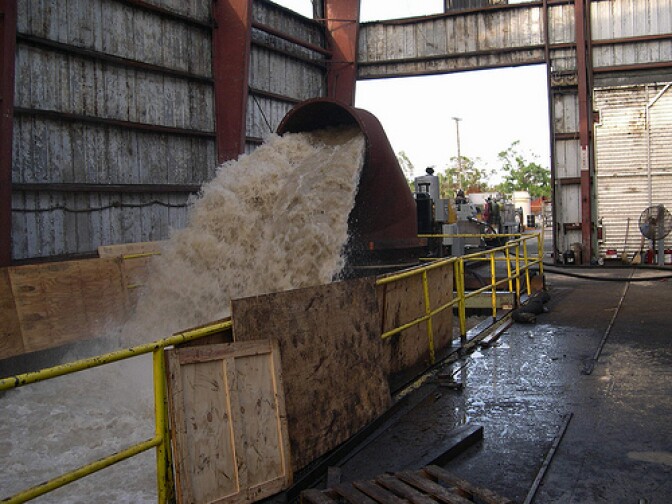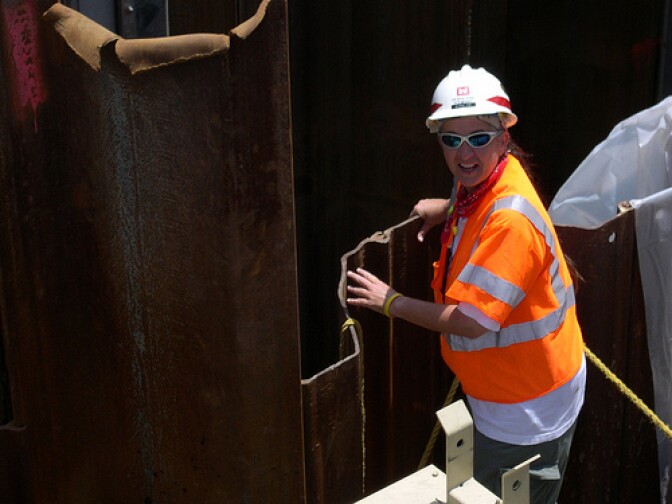Truth matters. Community matters. Your support makes both possible. LAist is one of the few places where news remains independent and free from political and corporate influence. Stand up for truth and for LAist. Make your year-end tax-deductible gift now.
This archival content was originally written for and published on KPCC.org. Keep in mind that links and images may no longer work — and references may be outdated.
Pumps Under Pressure: Testing troubles persist
As the fourth anniversary of Hurricane Katrina approaches, KPCC is reporting on a key piece of equipment intended to keep New Orleans safe. A Los Angeles-based employee of the U.S. Army Corps of Engineers says more than three dozen of the area’s water pumps would not work in a major storm.
KPCC’s Molly Peterson has uncovered evidence that backs up the whistleblower’s claims. She picks up the story with pump testing.
Molly Peterson: New Orleans has lived for three years now with new pumps meant to pull water out of its canals and keep the city dry. In a way, so has Army Corps engineer Maria Garzino. At her kitchen table, near L.A.’s Miracle Mile, she points out spaghetti-sized grooves on roughened steel parts. She took them from broken pumps.
Maria Garzino: Oh it's extraordinary.
Peterson: Ohh, you can actually see it.
Garzino: When you look in here, it should be as smooth as it can possibly be. Can you see the scoring that’s taking place?
Peterson: Garzino first saw the pumps at the Florida warehouse of Moving Water Industries. Her job was to monitor tests before that company shipped them to New Orleans. She got to the testing tank days after a severe fire.
Garzino: They were gonna remove all this muck from the sides of the building, and it ended up being washed, all of it, into the testing tank. It was like oatmeal.
Peterson: Garzino says procedures didn’t factor in water like that. During tests, pumps failed early and often. Pressurized oil, called hydraulic fluid, powered Moving Water’s pump system. But parts of that system overheated.
Garzino: The hydraulic fluid internal moving though that hose is so hot it can melt it from the inside out. The hose was melting from the inside out until it just finally gave way.
Peterson: Records from Army Corps inspectors based in Jacksonville, Florida also describe smoke and oil erupting from hoses. On top of that, vibrations shook the pump system until it failed. One day as that happened, Garzino saw people flee the testing tank.
Garzino: When I looked up to figure out what they were running from, the hydraulic hoses were like huge snakes. And it was fairly scary because the hydraulic hose, when it’s full of fluid you can barely lift it.
Peterson: Garzino and Moving Water Industries both say Army Corps managers in New Orleans approved shipping the pumps to the canals. So does Corps engineer Ray Newman, who manages pump operations for the 17th Street Canal.
Ray Newman: There was a lot of concern, what if we don’t have the pumps in June? And we have to close the gates because it’s a must to protect the walls. And of course if we wouldn’t have had pumps in service then we wouldn’t have been able to move the water out of the city.
Peterson: Moving Water Industries declined an interview request. In its account, Army Corps project managers repeatedly told the company this was “not business as usual.” The Corps’ Maria Garzino says urgency doesn’t excuse cutting corners.
Garzino: If they couldn’t meet the requirement they would ask for and receive a lesser requirement they had a chance of meeting, and when they found they couldn’t meet the requirement still, they got permission to relax those testing requirements even further.
Peterson: Newman says more troubleshooting in the factory would have been a luxury. But only a Katrina-like storm could send enough water to canals to permit full field testing. That hasn’t happened. Once the pumps were in place, the Army Corps tried to run them, but problems surfaced again. Garzino opened the pumps and found one way they failed – trapped air helped to shred the steel parts.
Garzino: It’s like opening up your oil can and taking metal shavings and shoving them into your motor. Then turning your car on and seeing how far these metal shaving can get through the valve stems, the pistons – how may of these end up fused in places they shouldn’t be.
Peterson: Army Corps engineers found other problems, and changed out parts to address them. Federal rules required that the pumps meet standards to complete the contract. Extra repairs delayed official acceptance of the pumps for another year. Public records of this testing are incomplete and inconsistent. On days a summary sheet shows that a pump passed the test, individual records show catastrophic failures.
Acceptance Testing: Claudio filled and ran pump 2E for less than 10 minutes and is convinced it has an internal oil leak in the pump. We appear to have an epidemic of Durst drive oil circulation pump problems. Pump 2 west had a gear drive temp problem after 25 minutes so we’re shutting it down. The gear oil in the Durst overheated.
Peterson: No pump test record is complete. Some records include no data at all. Moving Water Industries says it stands by the quality of the pumps. So does New Orleans-based Army Corps engineer Ray Newman.
Ray Newman: I have a very high level of confidence, I don’t have a percentage I put on ‘em, but I know one thing: we had some real world experience there with Ike and Gustav.
Peterson: Newman harbors that level of confidence now. But the Army Corps in New Orleans and beyond has been investigating its own pumps for at least three years. More about the way the Corps, Congress, and other federal agencies have monitored the pumps tomorrow.









